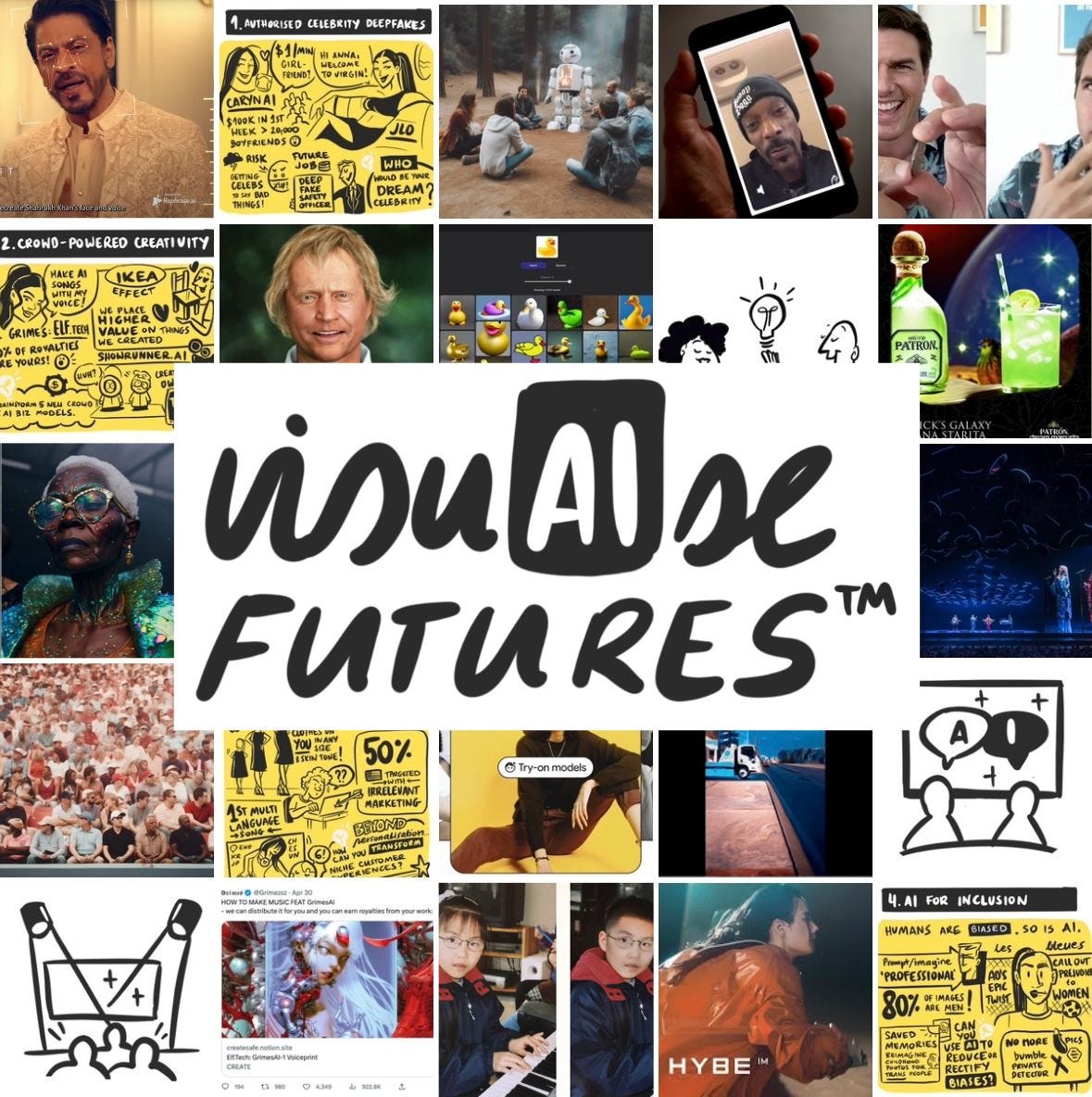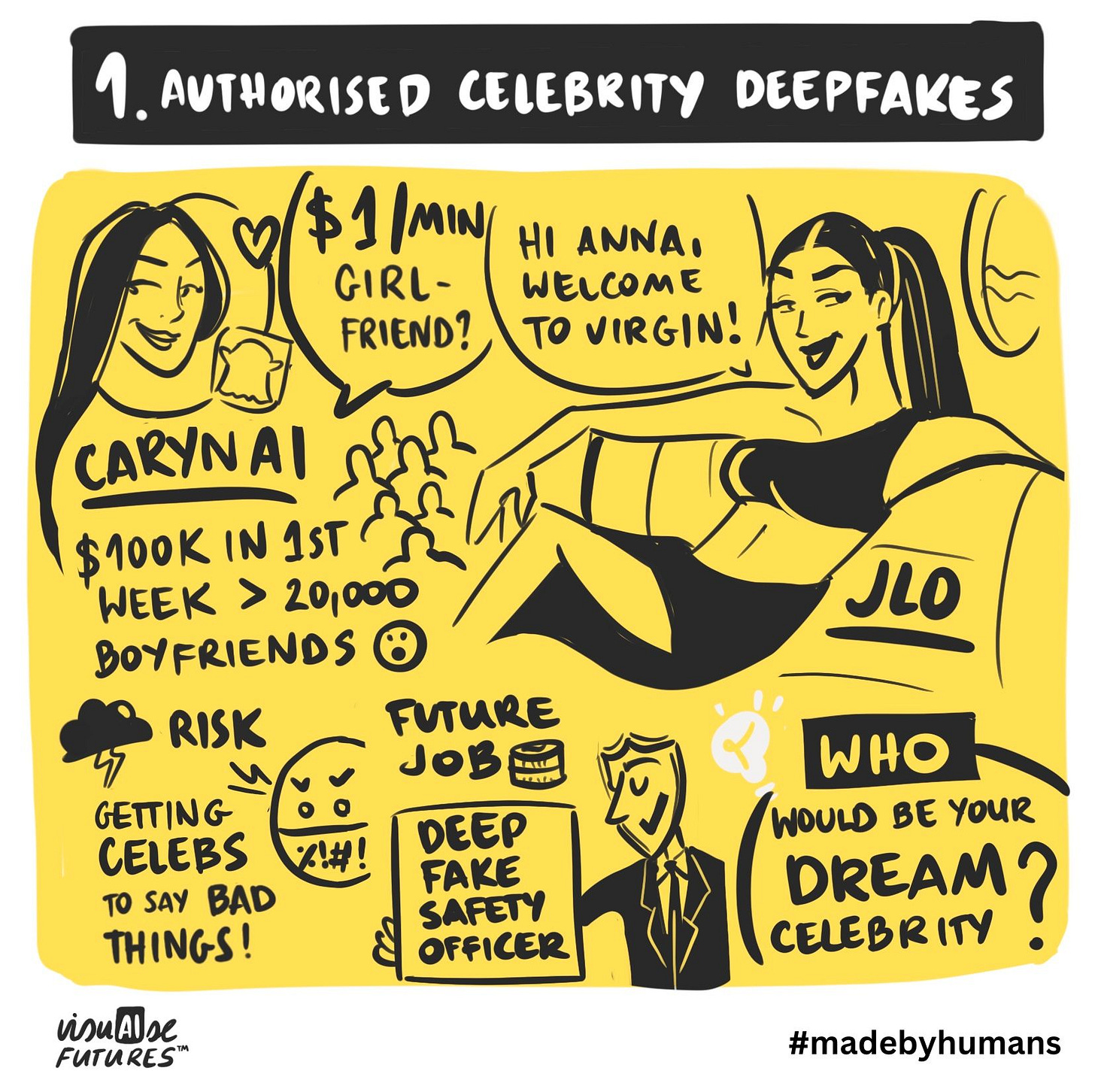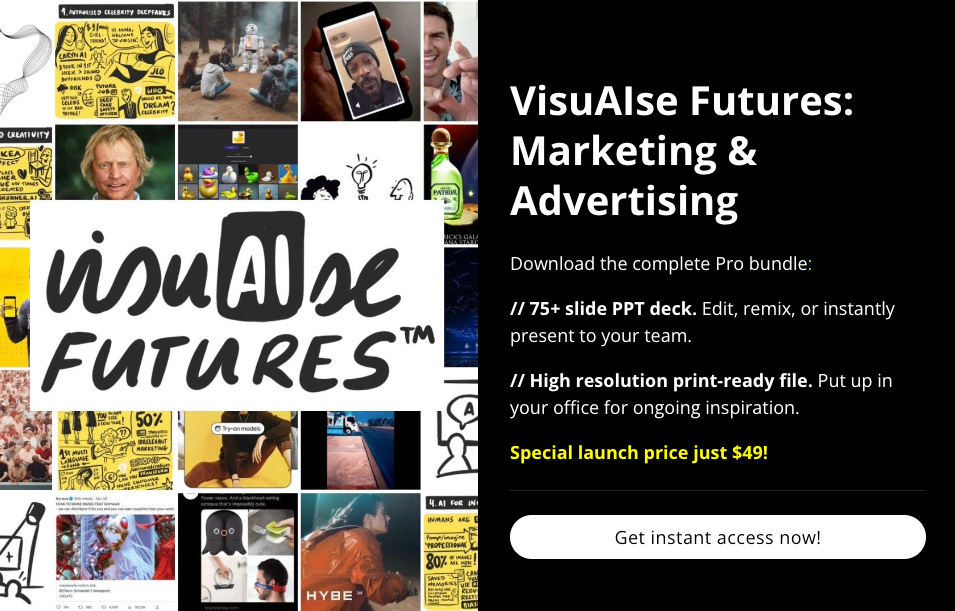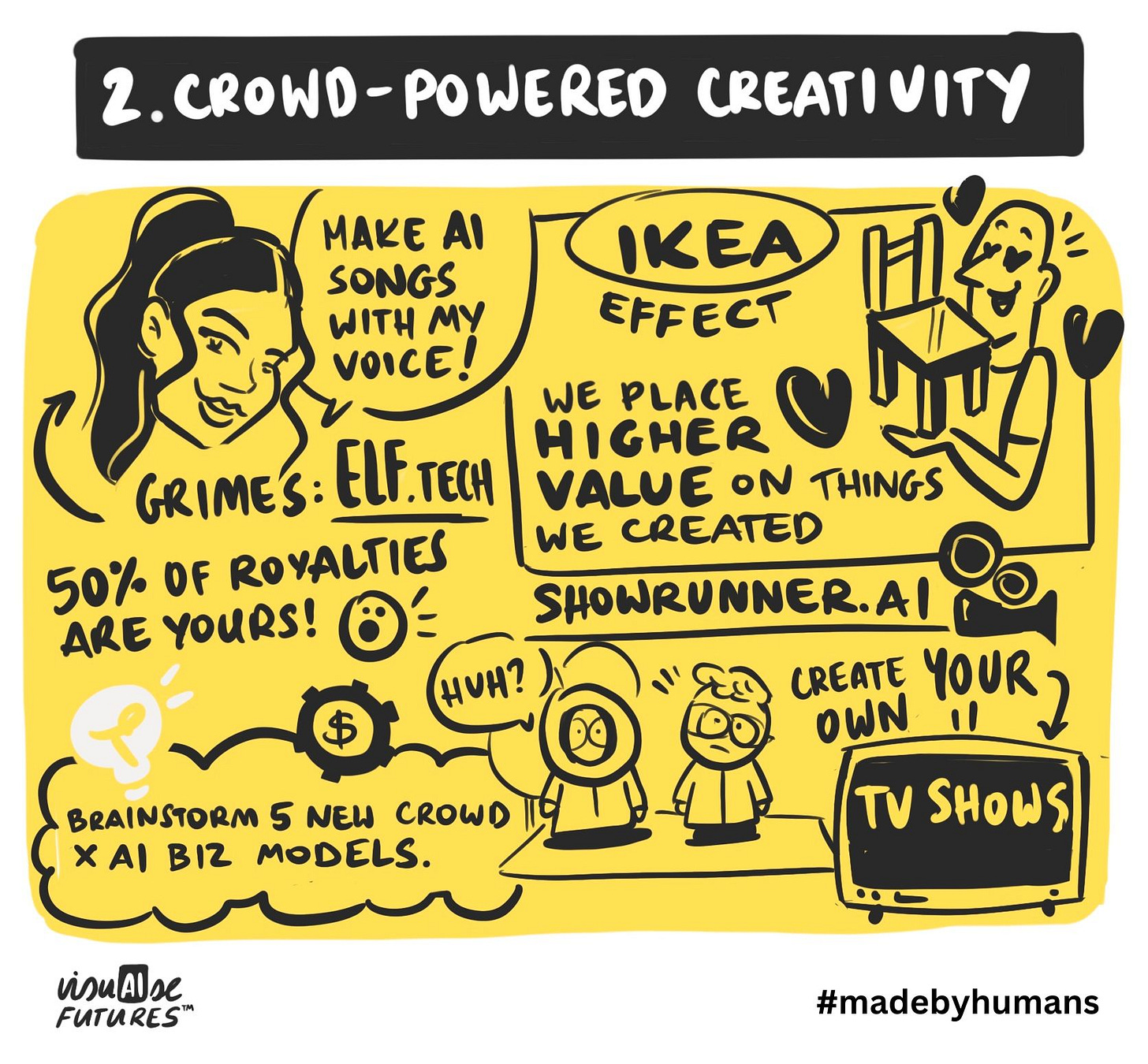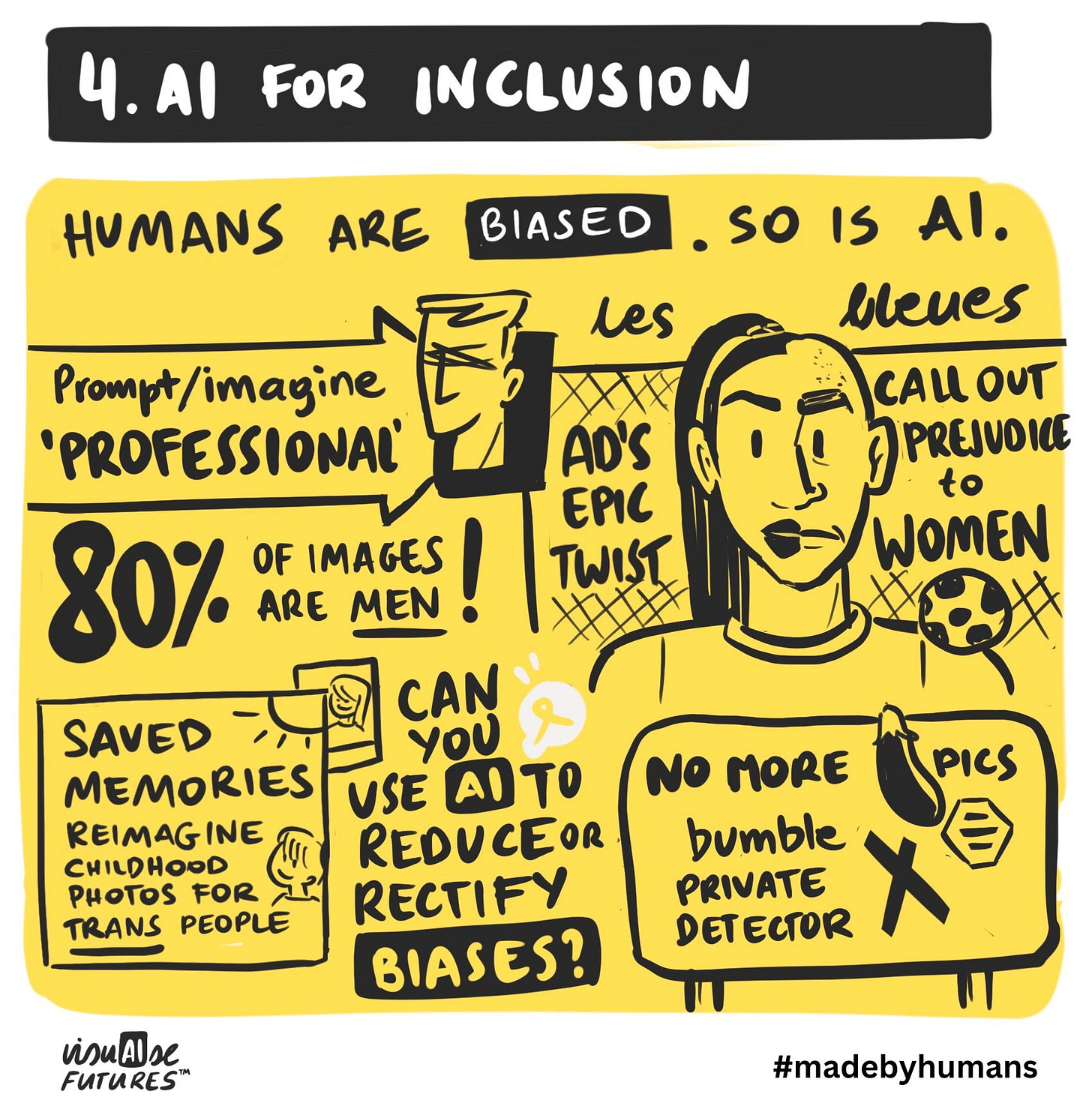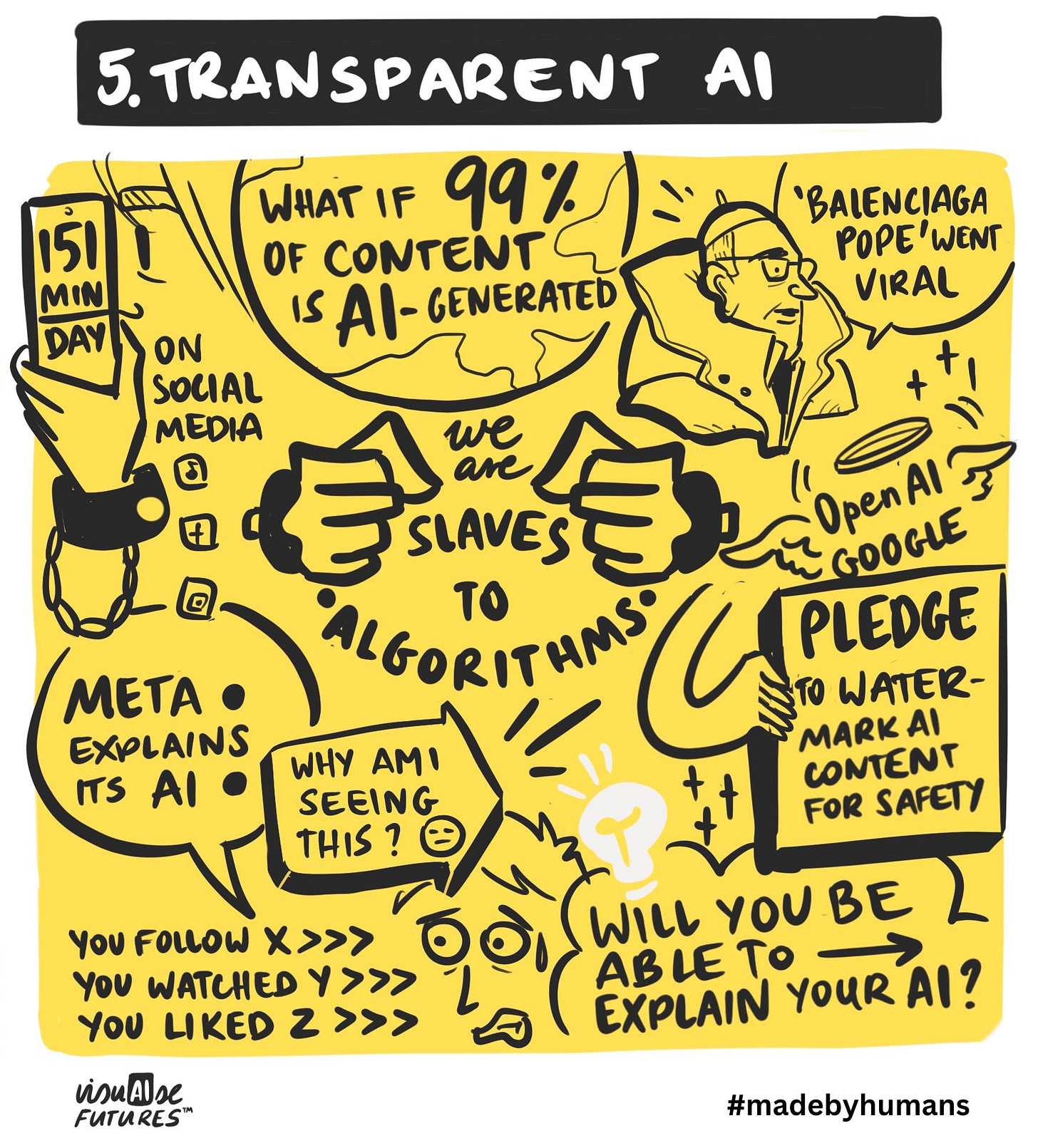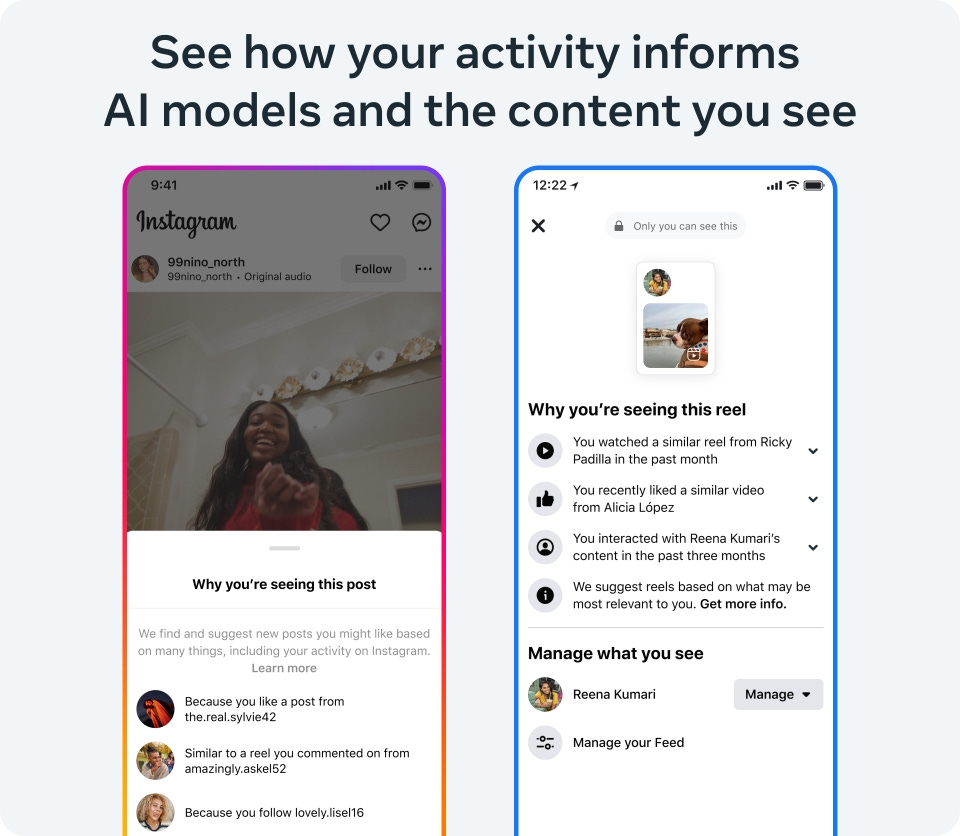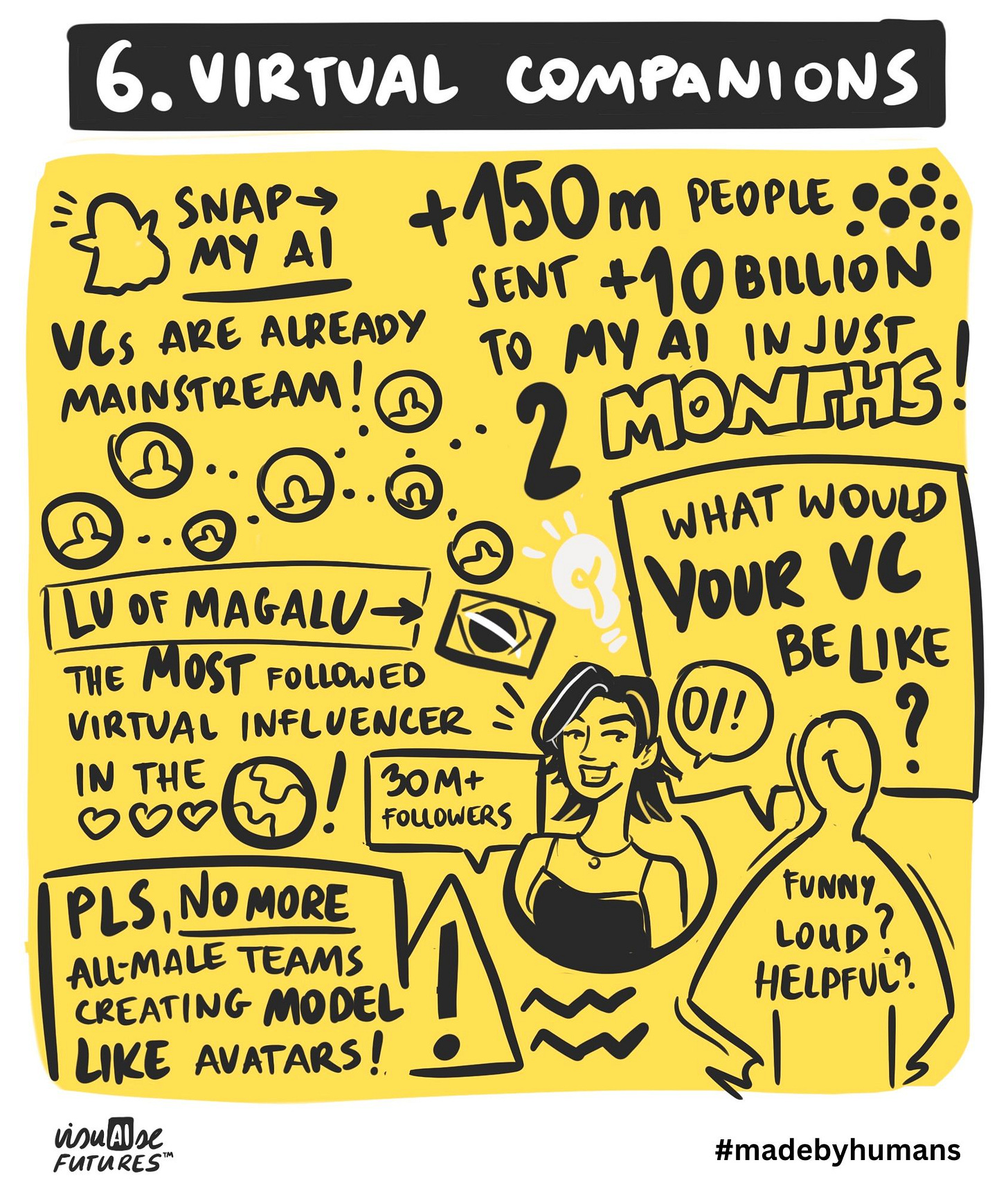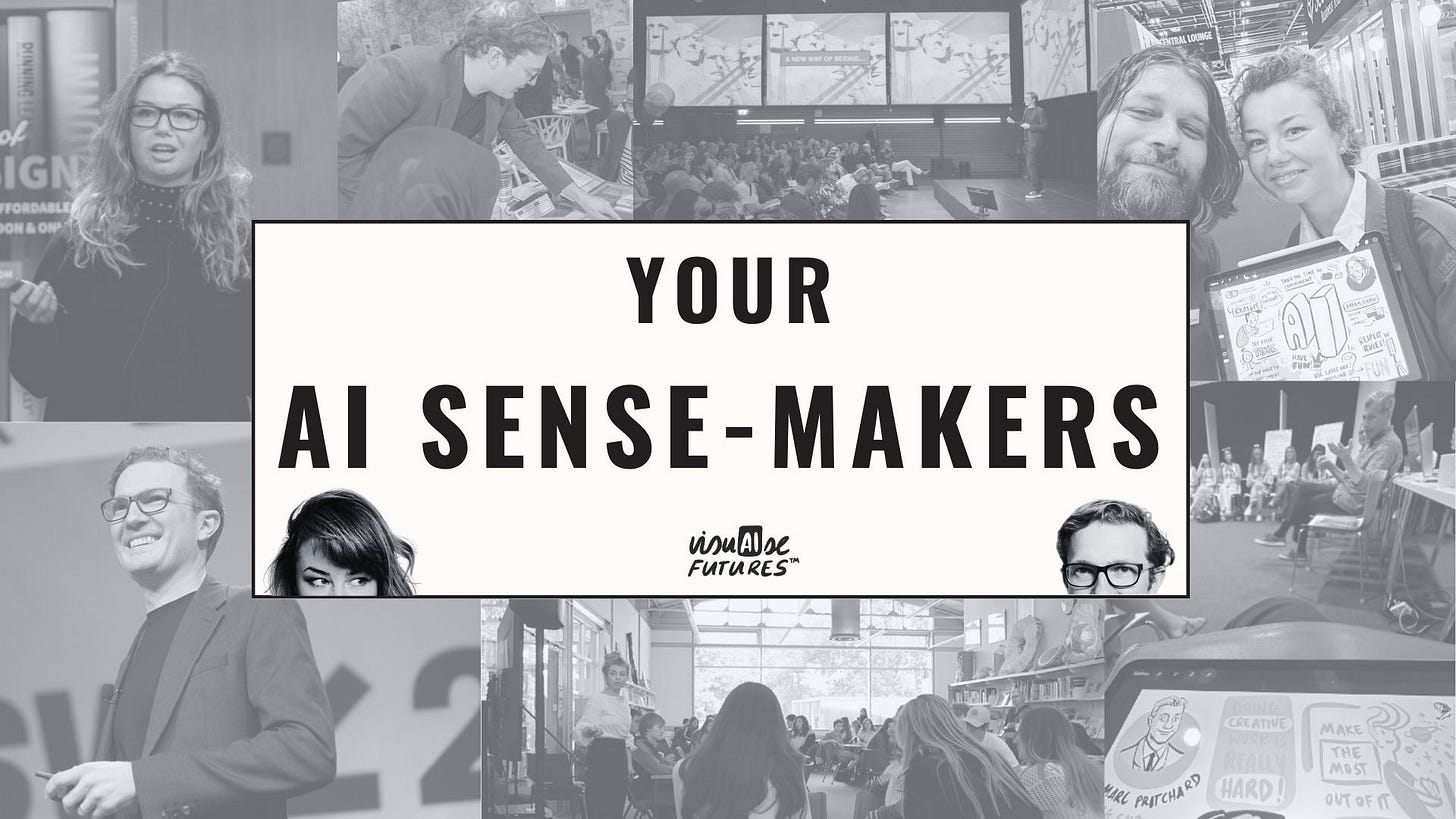Most writing about AI reads like it has been written by an AI.
It’s not wrong. But it’s not accessible or actionable. It’s not inspiring.
Welcome to VisuAIse Futures, a new collaboration from Natalia Talkowska and Henry Coutinho-Mason – two curious humans with 20+ years collective experience of helping large organisations navigate change.
This first edition focuses on the Marketing & Advertising industry and highlights 6 emerging AI innovation opportunities, supported by 40+ data-driven insights and 30+ real world innovation case studies.
For B2C brand marketers or creatives in agencies, this isn’t just a long read that you paste into your team’s chat channel and feel momentarily smart. This is your next winning pitch, breakthrough campaign, or team meeting – all rolled into one and ready-to-go.
The big ideas, people-centred insights and compelling stories below won’t just save you hours, they will make you an indispensable human in the age of algorithms.
What do you think of this first issue? Want to bring us to your next AI-focused meeting or event? Let’s chat!
Thanks for reading,
Henry and Natalia.
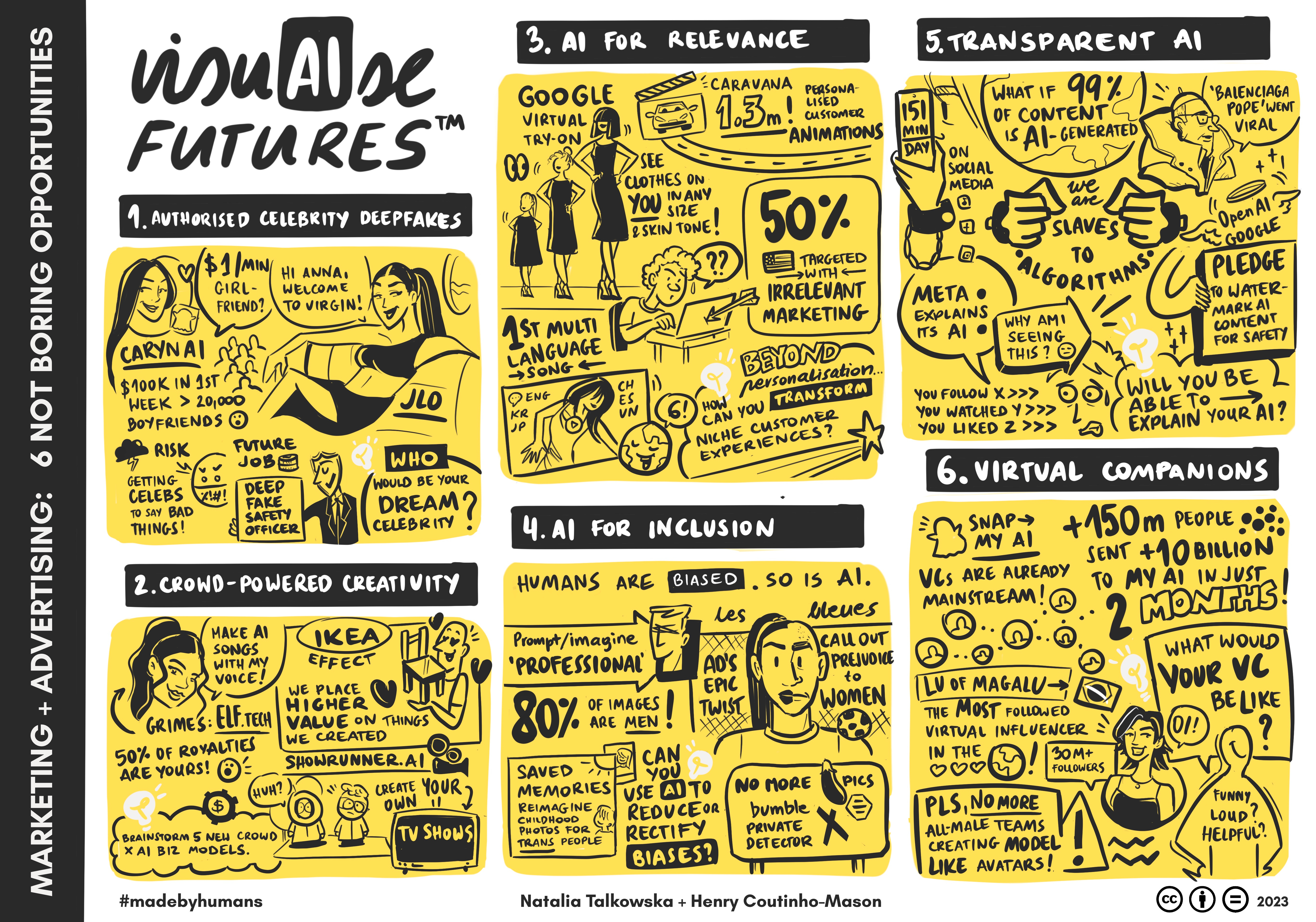
1. Authorised celebrity deepfakes
What if…celebrities actually wanted to create digital clones of themselves?
Deepfakes aren’t just about revenge porn or misinformation any more. Jennifer Lopez can now personally invite you (yes, you!) on a cruise. Your favourite Snapchat influencer can be your girlfriend. Virtually, and for a price. Bands can tour for years, even when their bodies aren’t able to dance for hours each night. Soon your imagination will be the only limit when it comes to content-driven experiences. That, and an army of lawyers ;)
What’s happening & why?
Deepfakes originated in 2017 on a Reddit forum where users used rudimentary AI tools to superimpose celebrities’ faces into porn clips.
A transformational moment was when @DeepTomCruise went viral on TikTok in early 2021. This wasn’t a NSFW deepfake, just him goofing around.
Social media has brought us closer than ever to celebrities, while you can even request personalised messages from many celebrities via platforms like Cameo.
Synthetic video and audio tools are increasingly good, cheap and widely available – check out Synthesia, Soul Machines and Eleven Labs.
Early Pioneers
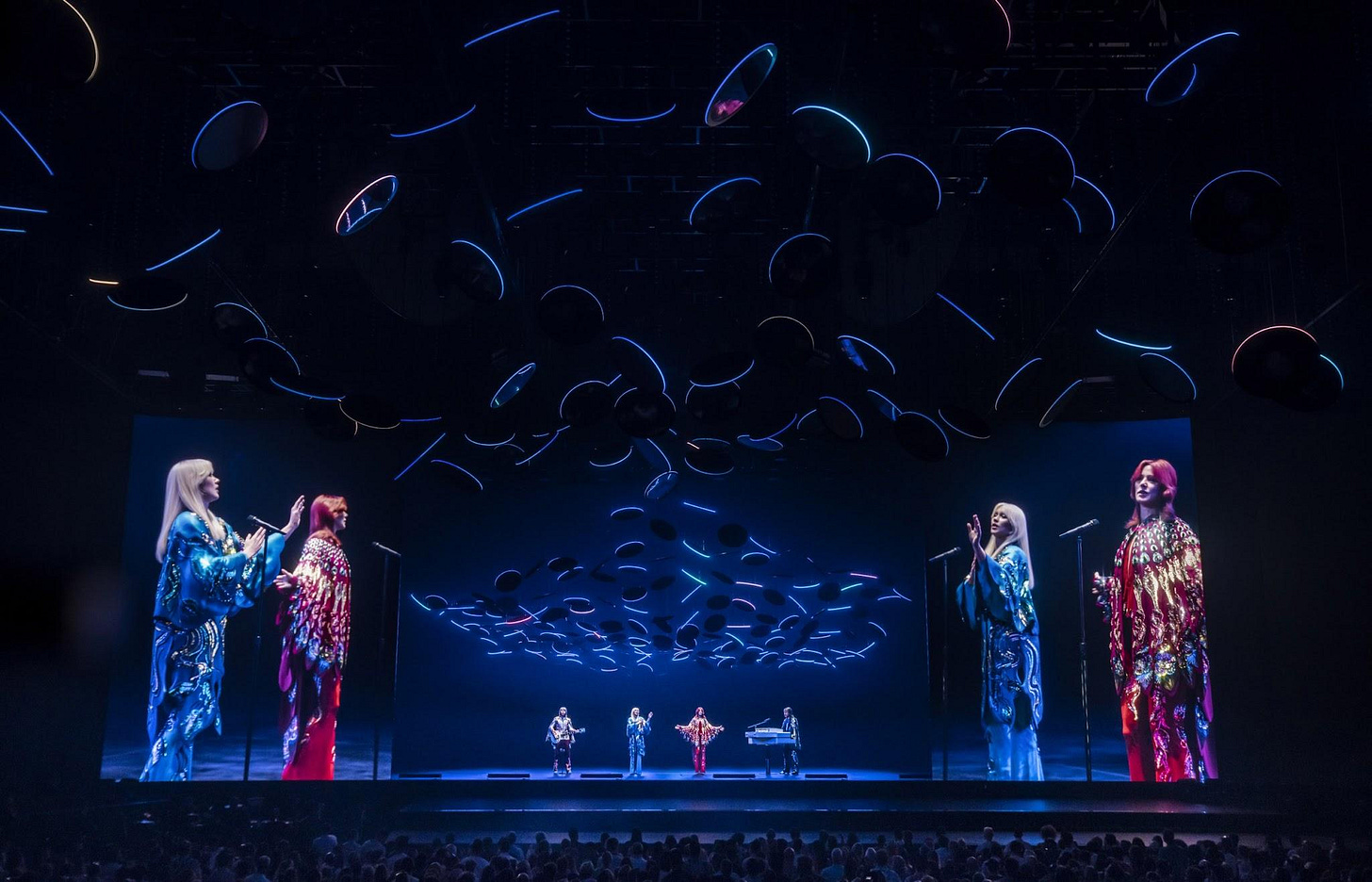
Jen AI. Virgin Voyages’ campaign enables people to enter in someone’s name and the reason for the vacation, and they will receive a custom invitation from a digital deepfake of Jennifer Lopez.
Messi Messages. Snack brand Lays created a microsite where users could create personalized messages from the footballer in English, Spanish, Portuguese, or Turkish.
Digital Jack. Jack Nicklaus, the famous golfer who is now aged 83, has a 38-year-old ‘digital twin’ that users can chat with.
ABBA Voyage. The Swedish supergroup created a concert performed by their digital Abba-tars, selling over 1 million tickets with plans to expand globally. While the experience isn’t based in generative AI, it is a powerful sign of how comfortable today’s audiences are with digital ‘fakes’.
Caryn.ai. Snapchat influencer Caryn Marjorie created a chatbot clone of herself; she claimed to make over $100,000 in the first week and reports having over 20,000 virtual boyfriends paying $1/ minute for her avatar’s company.
Where next?
Embrace the impossible. You can now create multi-language campaigns, as well as being able to work with older, or even deceased celebrities (as long as you tread sensitively).
Manage the risks. Getting a celebrity deepfake to say or do something horrible, and sharing on social is an unforgiving new online sport.
Explore new frontiers. Think beyond personalised messages – not everyone can fill stadiums like ABBA or be a virtual girlfriend like Caryn.ai, but can these inspire you to imagine entirely new and creative experiences?
Download the complete Pro bundle and impress your colleagues and clients – just $49!
// 75+ slide PPT deck. Edit, remix, or instantly present to your team.
// High resolution print-ready file. Put up in your office for ongoing inspiration.
2. Crowd-powered creativity
What if… AI could unlock your next new business model?
Crowdsourcing is nothing new. But AI will take it to new levels by making it even easier for people to move from idea to (passable) output with minimal technical skill. An avalanche of content is coming. Sure, most will be terrible. But there will be brilliance too, and a few standout marketers will attract and engage wildly democratic and diverse crowds to supercharge their brands’ creative output. Will you be one of them?
What’s happening & why?
“No matter who you are, most of the smartest people work for someone else” – Bill Joy
Easy-to-use AI tools mean that everyone is now an artist / designer / musician / writer. Well, not really. But certainly many more people are closer than before.
The IKEA effect – people place a disproportionately high value on things that they have even partially created.
Fan communities help people feel seen and heard. Lady Gaga’s Little Monsters harnessed social media back in 2009 (see also: Taylor Swift, BTS and Harry Styles); AI-native communities will soon follow.
Pioneers
Elf.tech. Grimes launches a platform for fans to create songs using ‘her’ voice, offering to split royalties with creators.
Showrunner AI. Fable Studios releases a demo of prompt-to-show custom AI-generated South Park episodes.
Create Real Magic. Coca Cola enabled people to download brand assets and submit AI artwork; 30 will be selected to join the brand’s Real Magic Creative Academy.
PATRÓN Dream Margarita. Tequila brand’s social campaign enables people to craft and visualise their perfect cocktail.
Where next?
Centaur thinking. Just as (wo)man + machine beats pure machine, what if your next crowd-campaign was a hybrid blend of crowd + machine + your team?
New business models > marketing. Crowd-powered campaigns aren’t hugely revolutionary. Could you explore more ambitious and disruptive models, like Grimes’ revenue sharing initiative?
Just because you can, doesn’t mean you should. You don’t have the reach or history of Coke, and probably aren’t as distinctive and engaging as Grimes.
Tread carefully. Releasing AI-generated shows during the Hollywood writers’ strike attracts headlines, but little goodwill. Ensure you adequately recognise and reward your contributors.
3. AI for relevance
What if… you could transform niche customer experiences?
The holy grail of marketing is ads that don’t feel like ads and instead feel like a message perfectly crafted, just for you. While today that means aggressively (and usually laughably incorrectly) personalised banner ads following someone around long after they have bought something; AI promises entirely new ways of tailoring the content, ads and ultimately the experiences you can offer.
What’s happening & why?
Personalised digital experiences aren’t new – think Spotify’s much-loved Discover Weekly playlists.
Yet despite the promises and claims of the adtech industry, half of all U.S. consumers said they were targeted with irrelevant marketing in the past 6 months (and the other half simply weren’t paying attention…).
The clue is in the name. Generative AI tools offer a step up in terms of the quality of content that can be created on-the-fly, as well as being exponentially more accessible. Which explains why over 90% of businesses are now investing in AI-driven personalisation initiatives.
Pioneers
Carvana Joyride. The used car retailer created 1.3 million personalised video animations for its customers, referencing when and where they bought their car.
Not Just A Cadbury Ad. In India, the chocolate maker used AI to enable the Bollywood star Shah Rukh Khan to promote over 130,000 neighbourhood stores to locals at Diwali.
Google Virtual Try On. Tool enables shoppers to view clothes on virtual models from XXS-4XL and with a choice of 10 skin tones.
MIDNATT Masquerade. South Korean music artist used AI to release his latest song in six languages – Korean, English, Spanish, Chinese, Japanese and Vietnamese.
Khanmigo. Educational chatbot can tailor learning to a students’ interests – so instead of ‘boring biology’ a basketball-mad student can learn the importance of nutrition on energy and performance.
Where next?
Customer experience is everything. Very soon, simply adding some superficial personalisation won’t impress anyone. Can your dynamic content transform your users’ experiences as profoundly as Google’s or Khanmigo’s?
Risk warning: focus on relevance not replacement. Levi’s was roundly criticized when it announced it would use AI-generated models to ‘increase diversity’.
Job of the future: dynamic content sensitivity designer, responsible for ensuring that dynamically-generated content is appropriate for its intended audience.
Open up the black box – read this alongside Transparent AI.
4. AI for inclusion.
What if … you could use AI to challenge prejudice, rectify injustice or foster inclusion?
Humans are biased. So is AI. It ‘thinks’ CEOs and doctors must be men, while domestic workers and nurses are women; lawyers and judges are white, while criminals and terrorists are black or brown. But the best (human) creativity challenges people and inspires fresh perspectives. So, the next time you’re given a ‘how can we use AI in our marketing?’ brief, could you add, ‘…to help address an important and relevant social issue?’
What’s happening & why?
People are becoming more and more aware of the biased outputs that AI generates.
When prompted with /imagine ‘a professional’, 80% of the images generated by MidJourney, an AI image platform, featured men.
And even more seriously, algorithms perpetuate existing discrimination – from racial bias in financial services, policing and healthcare to gender bias in recruitment (sadly, there are endless examples of this).
Stories matter. And the most memorable ads have always delivered an emotional gut punch – remember Guinness’ famous wheelchair basketball ad?
Pioneers
Les Bleues. Orange’s ad for the French women’s football team’s contains a clever twist that saw it called the ‘greatest sports ad of all time’. Watch it now, if you haven’t already.
Saved Memories Project. This feel-good initiative from Germany uses AI to reimagine childhood photos for trans people.
Fashion Show for Seniors. Nigerian AI artist Malik Afegbua creates images of elderly models in Afro-futuristic clothing to highlight their absence from real world fashion shows.
Voice-enabled Makeup Assistant (VMA). Estée Lauder’s free app scans users’ faces and generates voice instructions to help visually impaired people apply makeup better.
Private Detector. Bumble, the female-focused dating app open-sourced its tool to automatically identify and blur lewd images, enabling users to choose whether to view them or not.
Algorithm for Life. Rolling Stone Brazil scanned Kurt Cobain’s diaries, and used them to create a tool that could spot social posts from people at risk of depression.
Where next?
Zig when others zag. There’s endless AI doomerism, which creates huge opportunities to stand out and subvert this narrative with creative initiatives that show how AI can be used for social good.
Open-source your solutions. Could you show true leadership by giving away your AI-powered solutions, as Bumble did?
Lean into the long-term. The best brands will connect their initiatives with existing brand commitments so that they don’t come across as opportunistic bandwagon-jumpers.
5. Transparent AI.
What if … you could open up the black box?
That well-known futurist, Chrissy Teigen, captured the mood when she tweeted, “I thought the pope’s puffer jacket was real and didn’t give it a second thought. no way am I surviving the future of technology”. It’s now trivial to create fake, yet completely believable video and audio – which means no one can trust anything they see or hear online. Smart brands will recognise this pain point and confront it head on. This isn’t about will you use AI (spoiler: you will), but how you will use it.
What’s happening & why?
For now, AI is the story – Ryan Reynolds’ Mint Mobile ad saw him just reading from a ChatGPT-generated script. This won’t last for long, as AI becomes ubiquitous and therefore completely unremarkable.
Deeper questions are already being asked. Both from internal stakeholders (copyright, security, brand guidelines) and from audiences (misinformation, privacy, bias).
Here’s a thought experiment. We spend 151 minutes per day on social media, where we are slaves to algorithms. Now, imagine 99% of online content is created by AI. How do you feel?
Pioneers
Meta’s System Cards explain to people the ranking methodologies that its AIs use to show a specific post in their Facebook or Instagram feeds.
Watermarking AI-generated content. Open AI, Google, Amazon, Microsoft and others have made voluntary commitments to US authorities around AI transparency.
Ogilvy’s AI Accountability Act requires its clients to watermark AI-generated influencer campaigns or tag them with #PoweredbyAI.
Where next?
From experimental to everyday. Businesses need to trust AI – by 2025, 70% of CMOs expect to prioritise accountability for ethical AI marketing (perhaps the other 30% just hope the platforms will do it for them?).
Don’t expect a silver bullet. Technically, the AI detection arms race may be unwinnable; conceptually, when AI is embedded into every tool it will be hard (if not impossible) to define what is or isn't ‘created by AI’.
#HumanCreated. Abundance becomes boring, while scarcity creates value. As AI takes over our feeds, expect bold brands to lean into campaigns that are proudly AI-free. Nikon’s Natural Intelligence and the Red Cross’ Not Generated By AI show how powerful this approach can be.
6. Virtual Companions.
What if … your brand could become a (virtual) character?
Sci-fi writers have long dreamed of creating beings that are artificial, yet profoundly intelligent and even able to trigger human emotion – from Frankenstein to HAL 9000, and Roy Batty to Samantha. You might not have even noticed, but we have already passed this milestone. Will you embrace virtual companions (VCs), or dismiss them? Your next challenge – ensuring your creation doesn’t go rogue like in the movies ;)
What’s happening & why?
Exponential improvement. As with so much in the AI space, VCs are getting more real, fast. Both in terms of their ability to hold a conversation, and as platforms move from text chat to audio and video.
Virtual characters engender real feelings. Microsoft has an entire office set aside for the objects sent to Xiaoice, China’s most popular VC; Replika users raged on Reddit after the company restricted its NSFW chat.
Room to grow. 60% of YouTube viewers are open to watching content from creators who use AI-generated content.
Pioneers
Replika. The original VC promises to be “always here to listen and talk, always on your side”.
Lu of Magalu. The world’s biggest branded virtual influencer represents Magalu, Brazil’s biggest retailer, and has 30 million followers.
Woebot. This peer-reviewed VC draws from Cognitive Behavior Therapy to support patients with depression and other mental health challenges.
Snap My AI. The mainstream VC – with over 150 million people sending 10 billion messagges to the AI chatbot in its first 2 months!
Character AI. Create-your-own VC with this chatbot platform from two of Google’s leading AI researchers.
KFC’s Virtual Colonel. The brand’s pop-up virtual influencer had a 2-week stint living his best life on Instagram.
Where next?
With great power comes great responsibility. The media willingly reported the eye-catching story of a widow who blamed her husband’s suicide on his relationship with Eliza, a chatbot. Whether true or not, if it hasn’t already happened a similar tragedy undoubtedly will soon.
Representation matters! Let’s not have more all-male tech teams creating beautiful, subservient female avatars…please?!?
With those caveats in mind, why not brainstorm how your organisation’s virtual companion would look, sound and behave? What character traits would it have?
Now, over to you…
The pace of innovation when it comes to AI feels relentless. It is relentless. At times like this, it is easy to think that ‘everything will be different!’ It’s partially true – jobs, companies and entire industries are being transformed.
While this can feel intimidating, it’s also a huge opportunity for those who know how to harness these changes.
The first step to doing this is to understand what won’t change for your organisation. What are the ‘jobs to be done’ that you enable? What are the basic needs and wants that your customers look to you for?
Peel back all the technological innovation from this report and you’ll find some fundamental human needs that existed long before AI – relevance, trust, recognition, empowerment, connection.
Once you zero in on the basic human needs that will still be relevant to your audience and customers in a decade’s time, you’ll it much easier to get robust answers to the big question, “…and how could AI help me serve them better?”
If you want to dive deeper on this, check out Henry’s piece on Building A Future-Proofed AI Strategy.
Want some help?
Let’s run your next internal AI workshop and co-create your bespoke VisuAIse Futures Strategy Map.
This graphic and report should have already given you a TON of inspiration and ideas – even more so if you invested the princely sum of $49 for the full download with its print-ready, high-res poster file and fully editable PPT presentation.
But if you want even more, then we’ve taken the 10+ years experience that each of us has facilitating and illustrating 100+ workshops (for clients such as Accenture, Calvin Klein, Havas, HSBC, Google, Mastercard, McDonald’s, Tata, Telefonica), and applied it to create a workshop and deliverable that offers you:
A proven framework that ensures your AI strategy puts people and their needs first.
Real-world case studies of AI use cases – tailored to your industry and customers.
Hands-on workshop exercises where you will use a variety of AI tools to explore and brainstorm new opportunities and personas.
All this combined with a custom visual strategy map that can be digitally and physically shared with your wider team or clients. No more 100+ page post-event plans that no one ever looks at again!
Whatever you choose – good luck!
Sign up for free to be notified of updates, future editions, and other AI-related goodies :) No spam. Just content you’ll want to use and share.
And, if you got this far…then thank you. You’ve earned your right to have your say!



